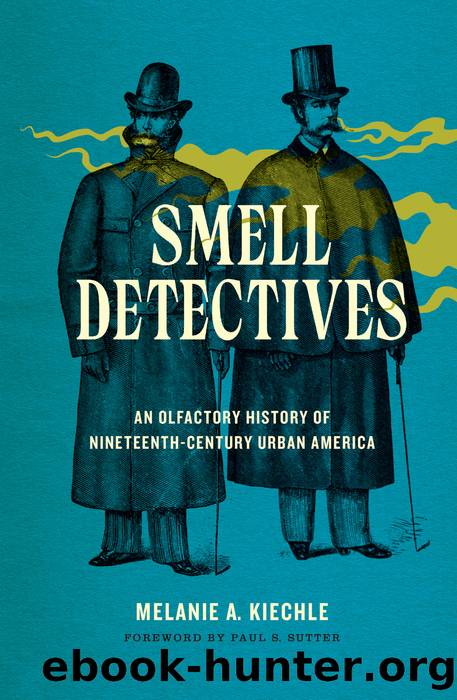Smell Detectives: An Olfactory History of Nineteenth-Century Urban America by Melanie A. Kiechle

Author:Melanie A. Kiechle [Kiechle, Melanie A.]
Language: eng
Format: epub
ISBN: 9780295741949
Google: 8HEpDwAAQBAJ
Amazon: 0295741937
Published: 2017-08-22T07:15:15+00:00
SIX
LEARNING TO SMELL AGAIN
Managing the Air between the Civil War and Germ Theory
IN SEPTEMBER 1873, THE SANITARIAN, A NEW MONTHLY JOURNAL dedicated to sanitary science and reform, mailed its sixth issue to subscribers. Nestled between articles that explained the appropriate methods of sea bathing and how to prevent cholera appeared a short paragraph titled simply âDisinfectants.â Without comment or elaboration, the paragraph quoted a studentâs response to an exam asking how disinfectants worked: âThey smell so badly that the people open the windows, and fresh air gets in.â1
The editors probably included this piece for some humorous relief from the long and serious articles about how to preserve and improve public health. One can easily imagine the bemused teacher smiling and shaking his head at the clever answer. However, readers of the Sanitarian recognized that the student, while evading the spirit of the question, was correct. The studentâs answer emphasized the paradox of disinfectantsâthey worked, but the powerful odors of chemical disinfectants required open windows and thus ushered fresh air, one of natureâs disinfectants, into the room.
The student stood between two worlds that were quickly diverging after the Civil War, as new scientific knowledge disrupted the logic behind traditional practices. Journals such as the Sanitarian and Herald of Health tried to bridge these worlds by appealing to both medical and lay audiences, applying the most recent theories and discoveries of the laboratory to the lived spaces of city and home. The journals attracted interested lay readers who, like the student, blended long-standing practices of opening windows, positioning fragrant plants, and airing rooms with newer applications of chemical disinfectants to kill disease agents and ensure health through access to âfresh air,â an old friend whose definition was changing.
In their discussions of and practices for ensuring health in urban spaces, Americans began questioning miasma theory before germ theory was widely introduced, understood, or accepted. The experiments of chemist Louis Pasteur in France and physician Robert Koch in Germany increasingly proved that microbes caused the eraâs deadliest diseases in the 1860s and 1870s, but the discovery of germs neither occurred overnight nor immediately changed ideas about health and illness. Instead of thinking of the turn from miasma to germ theory as a watershed moment that revolutionized medical practice and popular ideas about health, we might better see it as a turning of the tide. While the introduction of germ theory created a dramatic change overall, the transformation of beliefs and practices occurred in ebbs and flows spread across a variety of spaces and left behind scattered pools of unchanged thoughts. Decisions made in the home and discoveries made in the lab might have occurred in the same decades and in the same cultural context, but they did not necessarily happen for the same reasons.2
Women participated in conversations about disease etiology, sanitary science, and healthful environs. As they had been in antebellum homes, women were on the front lines of health preservation and disease prevention, and they guarded their familiesâ health both with methods proven
Download
This site does not store any files on its server. We only index and link to content provided by other sites. Please contact the content providers to delete copyright contents if any and email us, we'll remove relevant links or contents immediately.
Man-made Catastrophes and Risk Information Concealment by Dmitry Chernov & Didier Sornette(5921)
The Revenge of Geography: What the Map Tells Us About Coming Conflicts and the Battle Against Fate by Kaplan Robert D(4035)
Zero Waste Home by Bea Johnson(3780)
COSMOS by Carl Sagan(3554)
Good by S. Walden(3488)
In a Sunburned Country by Bill Bryson(3485)
The Fate of Rome: Climate, Disease, and the End of an Empire (The Princeton History of the Ancient World) by Kyle Harper(3003)
A Wilder Time by William E. Glassley(2818)
Camino Island by John Grisham(2763)
The Ogre by Doug Scott(2631)
Organic Mushroom Farming and Mycoremediation by Tradd Cotter(2626)
Human Dynamics Research in Smart and Connected Communities by Shih-Lung Shaw & Daniel Sui(2466)
Energy Myths and Realities by Vaclav Smil(2438)
The Traveler's Gift by Andy Andrews(2409)
9781803241661-PYTHON FOR ARCGIS PRO by Unknown(2323)
Inside the Middle East by Avi Melamed(2305)
Birds of New Guinea by Pratt Thane K.; Beehler Bruce M.; Anderton John C(2226)
A History of Warfare by John Keegan(2186)
And the Band Played On by Randy Shilts(2129)
